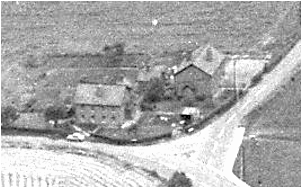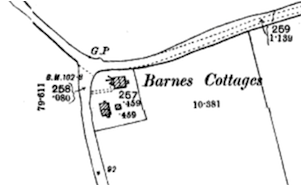Ernest John Everitt came from Springfield and worked at Hoffmann’s prior to the war. He joined the army early in the war and went to France by the end of June 1915. He was killed in October 1915 his dug-out was struck by a heavy shell. His family home was in Sandford Road. His step-brother was also killed during the war.
EVERITT, ERNEST JOHN,
Private, 9th (Service) Battalion, Essex Regiment
In October 1915 the 9th (Service) Battalion of the Essex Regiment participated in the Battle of Loos, holding positions to the north-west of the town in the Gun Trench-Hulloch Quarries sector. On 8th October 1915 the battalion was at a station, Vermelles Halte under ‘slow continuous fire’, and the following day the majority of the battalion moved to new billets at Noyelles les Vermelles.
A post-war history of the battalion continued:
“The old British trenches were occupied on October 12th, in readiness for the attack [by colleagues in the 35th Brigade] upon the Quarries [Hulluch Quarries] the next day. There the Essex were shelled and suffered some loss, the casualties including Major A. T. W. Constable, who was mortally wounded in the head whilst standing above congested trenches in the darkness directing operations.
As the attack [now known as ‘Action of the Hohenzollern Redoubt’] was delivered the Battalion moved forward, about 1.30 p.m., to occupy the trenches which the Suffolks and Berkshires had vacated for their advance. Several of the communications trenches were impassable on account of the heavy bombardment and made this movement extremely difficult. Two companies (C and D), however, less parties detailed for water and bomb-carrying, eventually reached a trench turning out of Breslau Avenue, where they remained, under Major Copeman, in support of the Berkshires, until they relieved the Suffolks in the Hairpin Trench, which was effected by 4 a.m. on October 14th.
Meanwhile the remaining companies found a small vacant portion of the old German line, except for a machine gun of the South Staffords, and occupied it until moved into the captured trenches. The next three days were spent in consolidation, including the construction by the R.E. of a strongpoint, There was almost continuous bombing.”
Ernest was one of the casualties during that period, killed in action on 13th October 1915 when his dug-out was struck by a heavy shell.
The Essex County Chronicle of 11th February 1916 reported:
“Mr G Everitt, of Springfield, has just heard that his son, Pt E J Everitt, 9th Essex Regt., who was reported missing, believed killed, on October 13th is now reported killed in action. Deceased, with four others, was in a dug-out when it was struck by a heavy shell, and all were buried.”
Ernest has no known grave and is commemorated on the Loos Memorial at Dud Corner Cemetery, Pas de Calais, France, on the Civic Centre Memorial, Chelmsford and on the Springfield Parish Memorial at All Saints’ Church. Ernest was entitled to the 1914-15 Star, British War Medal, and Victory Medal.
The 1918 Register of Electors listed Ernest’s father and step-mother still at Barnes Cottages in Sandford Road. His father died in 1935.
Ernest’s step-brother, Joseph Prentice, also lost his life in the First World War and is also commemorated by Chelmsford’s Civic Centre Memorial.
131013


Ernest was born in Springfield on 28th May 1892, the son of George John Everitt and Annie Everitt (nee Martin). His father had been born in Widford in 1860; his mother in Chelmsford, c1859. The couple had married in 1883. Ernest was christened at All Saints’ Church, Springfield on 23rd June 1892. At the time his father was a ‘labourer, of Springfield.’
His siblings included David George Everitt (1884-1953), Arthur Everitt (1887-1954), James Frederick Everitt (1889-1891), Minnie Isabella Everitt (born in 1894) and William Everitt (born on 13th March 1896 and christened at Holy Trinity Church in Springfield on 9th April 1896). All were Springfield-born.
In 1891 the family had been living at 10 Knott’s Croft (part of Arbour Lane) in Springfield where Ernest’s father was an agricultural labourer. His mother is thought to have died in 1898, and the following year his father married Mashbury-born widow Sarah Ann Prentice.
The 1901 census listed seven year-old Ernest living with his parents and three siblings at Waterhouse Lane, then part of
Writtle. Ernest’s father was a stockman on a farm, while his brother Arthur was a gardening apprentice.
In 1911 the census listed 18 year-old Ernest boarding in the home of the boot repairer William John Stimson, 25 Hall Street, Chelmsford. Ernest was a machinist as Hoffmann’s ball-bearing factory in Chelmsford. His brother Arthur, a postman, was also a boarder in the household. Meanwhile their parents and brother William were living in Barnes Cottages, Sandford Road in Springfield (pictured). The cottages were demolished in the late 1980s and stood at the northern end of what is now Chelmer Village Retail Park.
Ernest lived and enlisted at Chelmsford, serving as Private 12570 in the 9th (Service) Battalion of the Essex Regiment. The battalion was part of the 35th Brigade in the 12th (Eastern) Division, one of six Divisions which together formed the first part of ‘Kitchener’s Army’ from August 1914. The battalion formed in initially at Shornecliffe in Kent. After training the battalion, including Ernest landed in Franceat the end of May/start of June 1915, entering the front line in July 1915 near Ploegsteert Wood, Belgium, close to the French border, a comparatively quiet sector.
